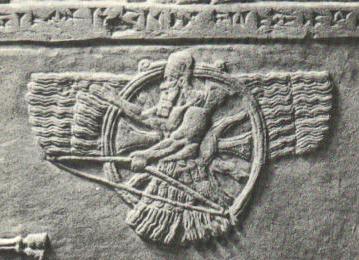
| Isin/Larsa Period |
| Old Babylonian Period |
| History |
| Home |
 |
| Ashur, the Assyrian national god |
This period can be divided into two sub-periods: the Proto-Historical (or period of foreign domination) (c.2500-c.2000) and the old Assyrian (c.2000-1392).
The Assyrians settled the area c.2500. They were a warlike tribe that was a mixture of non-Sumerian and Semitic immigrants. They were dependent culturally on Sumer. At this point, upper Mesopotamia was a semi-civilized back water. It was almost always ruled by its more civilized neighbors. Originally called Subartu, it was later called Assyria, after the city Ashur, which was itself named after their supreme god. The Assyrian Kings List lists their first seventeen kings as those that "lived in tents", i.e. they did not rule in Ashur. If they were not purely mythical, they were most likely tribal sheikhs of Hurrian or other non-Semitic extraction. They would have probably been vassals to the various Sumerian and Akkadian powers. There is no historical evidence that Ashur was independent before the second millennium (i.e. end of the Ur III Period).
| Map of Ancient Assyria |
The Kings who Lived in Tents
Tudia (c.2500)-Around this time there is mentioned in a tablet from Ebla a certain Du-udia, ruler of Ashur. Are they one and the same?
Adamu
Yanqi
Sahlamu-Probably the Kitlamu of some translations.
Harharu
Mandaru
Imsu
Harsu
Didanu
Hanu
Zuabu
Nuabu
Abazu
Belu
Azarah
Ushpija
Apiashal
Kings in Ashur ("Kings Who Were Ancestors")
Hale-Son of Apiashal.
Samanu-Son of Hale.
Hayanu-Son of Samanu.
Ilu-Mer-Son of Hajanu.
Yakmesi-Son of Ilu-Mer.
Yakmeni-Son of Yakmesi.
Yazkur-Ilu-Son of Yakmeni.
Ila-Kabkabi-Son of Yazkur.
Aminu-Son of Ila-Kabkabi.
Sulili-Son of Aminu.
Kings of Ashur
Kikkia (c.2000-1985)-The first independent King of Ashur?
Akkia (c.1985-1970)
Puzur-Ashur I (c.1970-1960)-He was possibly Akkadian.
Shallum-Ahhe (c.1960-1945)
Ilushuma (c.1945-1906)-He raided deep into Sumer during the reign of Ishme-Dagan of Isin.
Erishum I (c.1906-1867)-Son of Ilushuma. He left inscriptions mentioning the building of temples to Ashur, Ishtar, and Adad.
Ikunum (1867-c.1860)-Son of Erishum.
Sargon I (Sharru-Kin) (c.1860-1850)-Son of Ikunum. His actual name was Sharru-Kin.
Puzur-Ashur II (c.1850-1830)-Son of Sargon.
| Map of Assyria under Eshnunna |
Naram-Sin (c.1830-1815)-The King of Eshnunna. He conquered Assyria and controlled it for a time.
Erishum II (c.1815-1809)-He was overthrown by Shamshi-Adad.
| Map of Shamshi-Adad's Empire |
Shamshi-Adad I (1809-1781)-He was the son of Ila-Kabkabu, king of the small city-state of Ekallatum. When Naram-Sin of Eshnunna conquered Assyria, he also captured Ekallatum and Shamshi-Adad fled to Babylon. When the time was right, he returned and retook his city (1815). Six years later he conquered Ashur. He waged a vigorous campaign of expansion. He attacked and defeated the Sheikh of the Simalites (the father of Iahdun-Lim, the future King of Mari) and took land from Mari and Babylon. His empire included parts of the mountain region to the north, as well as Mari and Babylonian territory. In 1796 he was able to install one of his sons as King of Mari. He took the title of "King of the Whole" and his reign was one of patriarchal absolutism. His Kingdom has been called the First Assyrian Empire. The historian Georges Roux says that it more properly should be called the Kingdom of Upper Mesopotamia because the men of Ashur played no part in it. He does figure in the Assyrian Kings List, but he was an usurper and was later rejected by Assyrian tradition. He died in battle.
Ishme-Dagan I (1780-1741)-Son of Shamshi-Adad. He was defeated by Zimri-Lim of Mari and lost the overlordship of Syria. In the mid-1770's Elam sacked Ekallatum and Shubat-Enlil. In 1771 Eshnunna occupied Ekallatum. He later became a vassal of Hammurapi.
For the rest of this period, the Assyrian kings controlled just the strip of land along the Tigris from Nineveh to Babylonia.
| Map of Mesopotamia c.1730 BC |
Mut-Ashkur (c.1730-1720)
Rimush (c.1720-1710)
Asinum (c.1710-1706)
Anarchy (1706-1700)-Seven usurpers fight for domination:
Ashur-Dugal
Ashur-Apla-Idi
Adad-Salulu
Nasir-Sin
Sin-Namir
Ipqi-Ishtar
Adasi
Belu-Bani (1700-1691)-Son of Adasi.
Libaia (1691-1674)-Son of Belu-Bani.
Sharma-Adad I (1674-1662)-Son of Libaia.
Iptar-Sin (1662-1650)-Son of Sharma-Adad.
Bazaia (1650-1622)-Son of Iptar-Sin.
Lullai (1622-1618)-Possibly an usurper.
Kidin-Ninua (Shu-Ninua) (1615-1602)-Son of Bazaia. The Shu-Ninua of some translations.
Sharma-Adad II (1601-1598)-Son of Kidin-Ninua.
Erishum III (1598-1586)-Son of Sharma-Adad.
Shamshi-Adad II (1585-1580)-Son of Erishum.
Ishme-Dagan II (1580-1564)-Son of Shamshi-Adad.
Shamshi-Adad III (1564-1547)-Son of Ishme-Dagan, the brother of Sharma-Adad II.
Ashur-Nirari I (1547-1522)-Brother of Shamshi-Adad.
Puzur-Ashur III (1522-1498)-Son of Ashur-Nirari. He signed a peace treaty with Burnaburiash of Babylon and established the border at the Samarra area.
| Map of Near East c.1500 BC |
Enlil-Nasir I (1498-1485)-Son of Puzur-Ashur. He became a vassal of Mittani.
Nur-Ili (1485-1473)-Son of Enlil-Nasir. Possible Mittani vassal.
Ashur-Saduni(1473)-Son of Nur-Ili. He reigned one month and then was overthrown by Ashur-Rabi.
Ashur-Rabi I (1472-c.1450)-Son of Enlil-Nasir. He seized the throne in a coup. Mittani vassal?
Ashur-Nadin-Ahhe I (c.1450-1430)-Son of Ashur-Rabi. Beginning with his reign, Assyria became a vassal of Mitanni. He was overthrown by his brother.
Enlil-Nasir II (c.1430-1424)-Brother of Ashur-Nadin-Ahhe. A vassal of Mitanni. He seized the throne in a coup.
Ashur-Nirari II (1424-1418)-Son of Enlil-Nasir. A vassal of Mitanni.
Ashur-Bel-Nisheshu (1418-1409)-Son of Ashur-Nirari. A vassal of Mitanni. He signed a new treaty with Babylon that was similar to the previous one.
Ashur-Rem-Nisheshu (1409-1401)-Son of Ashur-Bel-Nisheshu. A vassal of Mitanni.
Ashur-Nadin-Ahhe II (1401-1392)-Son of Ashur-Rem-Nisheshu. A vassal of Mitanni.
| Old Babylonian Period |